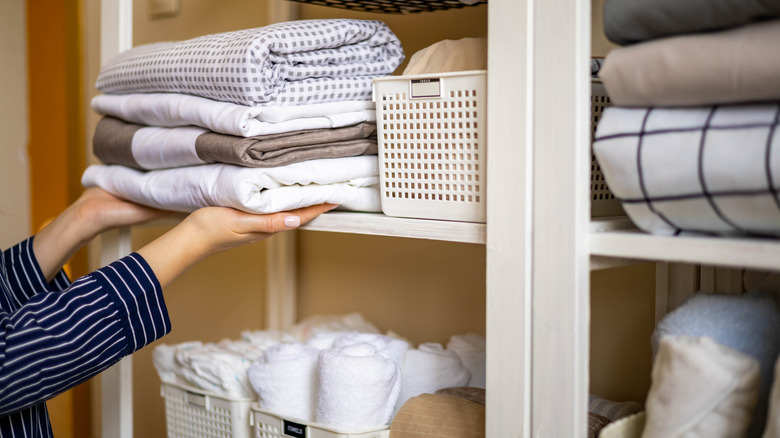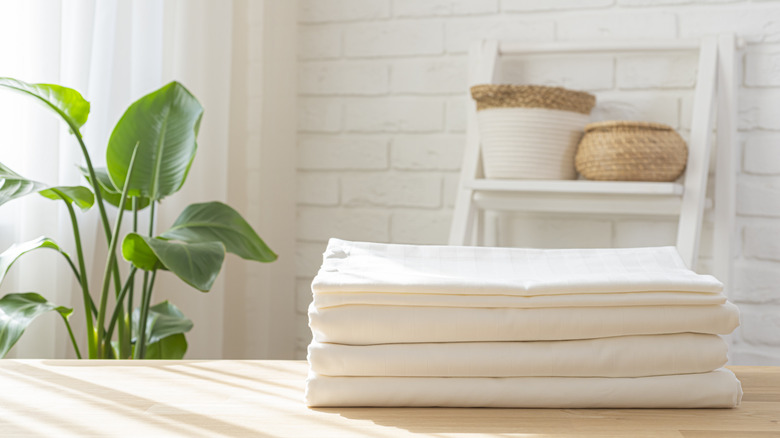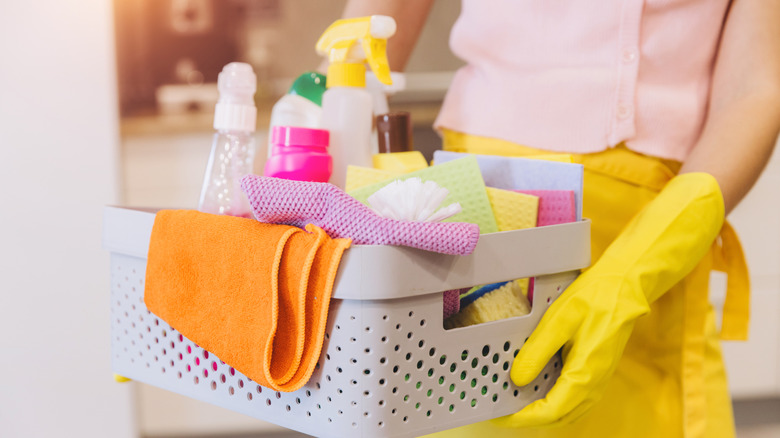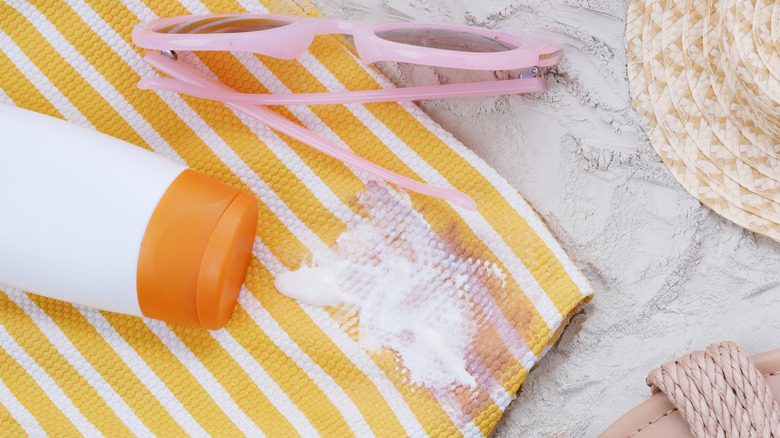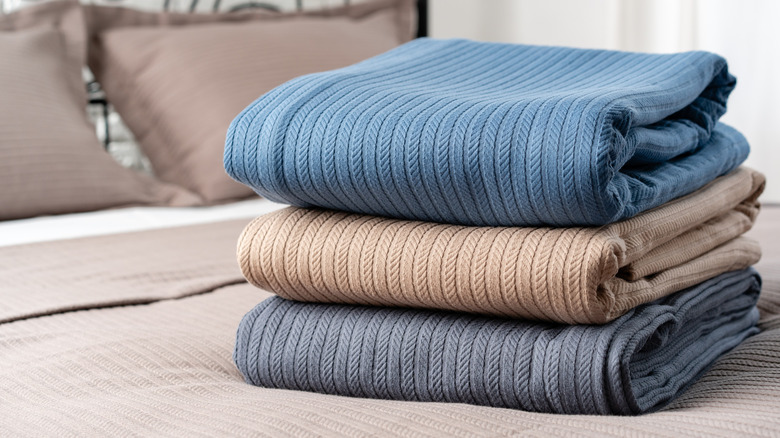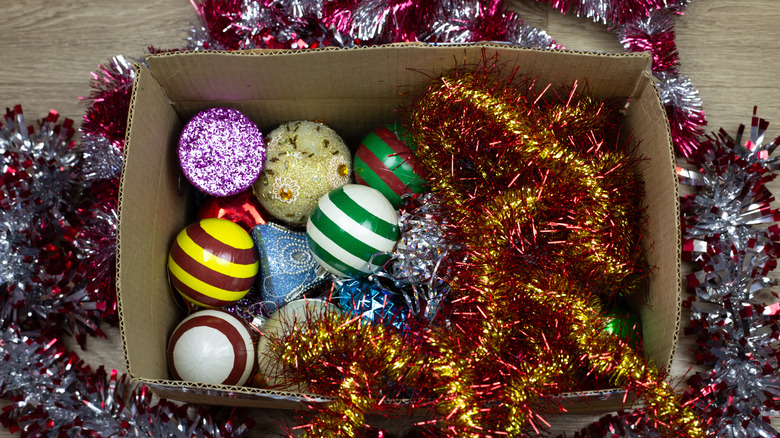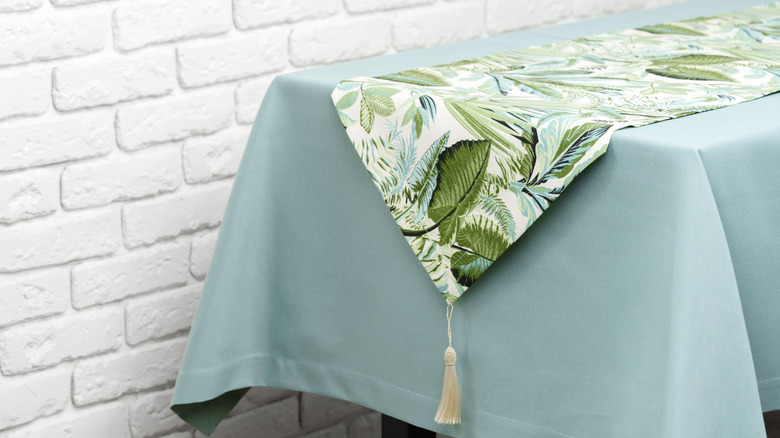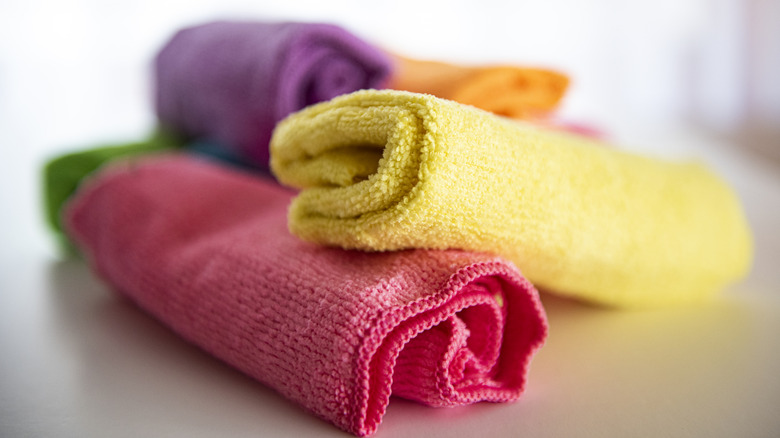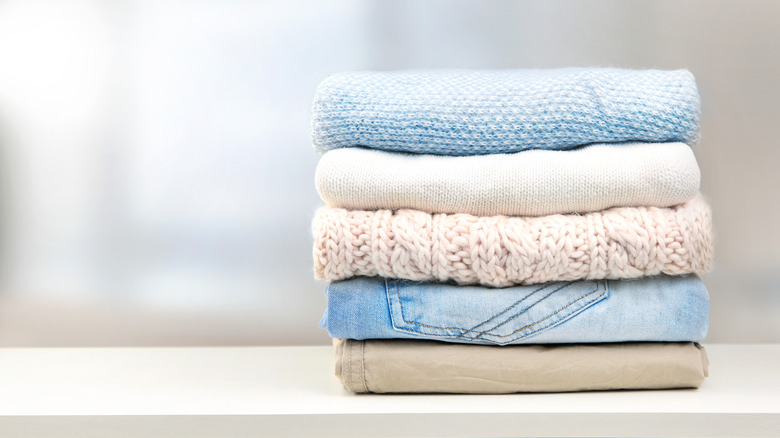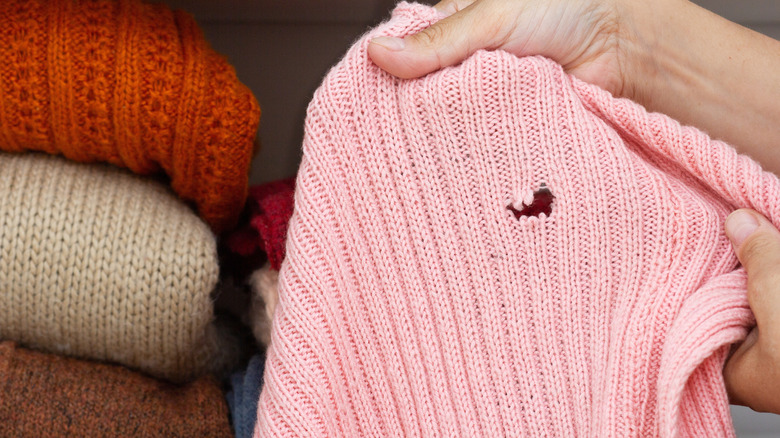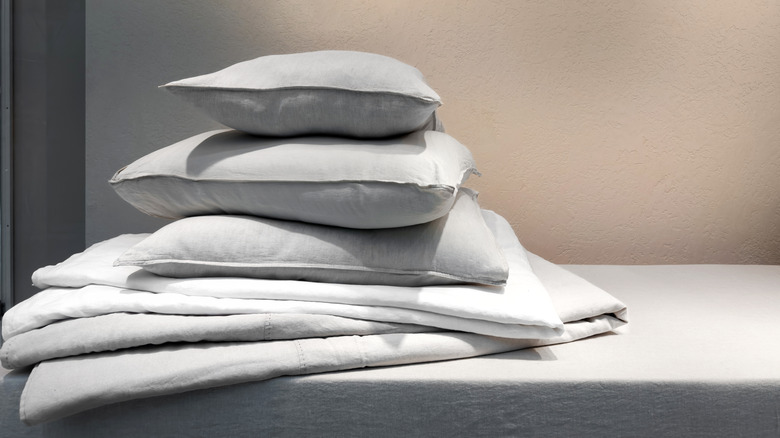Declutter Your Linen Closet By Tossing These 12 Commonly Stored Items
Your linen closet might not be an area of your home that you think of all that often. Linen closets are usually relegated to spare sheets and extra blankets — maybe you store your bulk toiletries and cleaning supplies there, too. But even if it's not a part of your usual routine, your linen closet is still a space that's well worth decluttering. Because it probably has shelves that you're not taking items from every single day, there are likely a few long-forgotten items hiding inside that are ready to be donated or thrown away. So, where should you start?
We've rounded up a list of every item in your linen closet that you should consider decluttering — and what to look out for when you do. Whether you're working with stained towels (are they still usable? Or is it time to throw them out?) or a linen closet bursting with dozens of spare blankets, you'll be left with a neat and tidy linen closet by the time you're done with this guide. And don't worry — you can still keep your favorite old throw blanket or emergency sheet set, too. We don't judge.
Outdated sheet sets that you no longer have use for
It's always a good idea to have a spare sheet set (or a few) on hand in case of an emergency. But when you declutter your linen closet, you should take inventory of all the sheets you have and see if they still fit your beds. Maybe you've upgraded from a queen to a king-sized bed recently, but forgot to pull the sheet sets that no longer fit out of your closet. You might even have a small collection of sheets from kids' beds that they've long outgrown. Don't forget about those pesky XL-style sheets that often come along with custom beds or college dorms, too: They can still fit standard beds, but will be loose over a standard mattress.
Pull out any sets that no longer fit your mattresses and donate them. If you have a full sheet set that includes pillowcases, don't forget to check those for size, too — if you've switched over to a non-standard pillow size or gotten rid of the sheet set your pillowcases belong to, it's probably time to donate those as well. At the same time, you can check for sheet sets that just don't fit your aesthetic anymore; if you have several sheet sets that you know you probably won't use again in your closet, feel free to get rid of most of them and only keep an emergency spare.
Expired cleaning products that are no longer effective
Linen closets are often used as a one-stop shop for all things laundry and cleaning-related. Whether you store bulk cleaning supplies in your linen closet or just keep a caddy inside, be sure to look through it while you declutter to see what might have expired recently.
Cleaning products can expire, breaking down over time, becoming less effective. Old sanitizers may not be able to get rid of all the bacteria on a surface, and expired stain removers will have less of the ingredients that make them good at removing stains. Some can even grow mold or start to smell bad. There's no scenario where it's worth using an expired cleaning product — sometimes, old cleaning products can even damage the surfaces you use them on if they've degraded enough. That's more than enough reason to throw out your expired cleaning solutions guilt-free. Just make sure you're disposing of them properly; always check the bottle or manufacturer instructions instead of dumping the products down the drain.
While you're busy getting rid of cleaning products that have expired, you can also go through and see if there are items that you just don't find yourself using anymore. Trashing or donating these items can help you free up more space. Once you're left with non-expired cleaning products that you actually use, give them one final check to make sure that they've been stored properly — for example, that your pack of cleaning wipes are still wet. This way, you can feel confident that you're only keeping cleaning supplies that you can rely on when the time comes.
Keep stained towels to a minimum
We're of the mindset that keeping a few stained towels on hand is actually a great idea. If you've ever dyed your hair, for example, you probably want to rely on a stained towel for drying your hair so that you don't accidentally stain your favorite towel set. These are more likely to live in your linen closet than anywhere else, which is perfectly fine. However, you don't need to keep an excess of stained towels around, either. Keeping just one or two in your linen closet is usually more than enough. Go through your closet to look for towels that are stained enough that you wouldn't want to set them out.
Once you've identified the towels you want to get rid of, it's always a good idea to think about upcycling them. Cutting your old towels into cleaning cloths and rags is a great idea; you can use these for your floors, counters, bathrooms, and even your car. Some people like to shred them up and use them to stuff crafting projects, like pillows or plushies. As long as the stains aren't transferring off the towel, you can also use them as pet bedding — and don't forget to check in with your local animal shelter to see if they'd like some, too.
Limit the amount of gift bags and boxes you have
Gift bags and boxes often end up in the linen closet. Gifting supplies aren't something you're constantly using throughout the year, so they may start to pile up before you realize it. One option is to move them somewhere else, such as into a craft room or storage space for seasonal items. Even if you want to keep these items in the linen closet, however, you should look through them and see which ones you might need to get rid of.
Check through your gifting supplies to see if there's any damage to them. We all love reusing gift bags, but sometimes we don't realize until it's too late that there's a mark on the edge or a huge dent in the side. Look for bags with broken handles or marred gift boxes, and don't forget to check for crumpled-up tissue paper, too. Anything with a hole in it has to go. While you're at it, also check for gift supplies that are too personalized to reuse: Gift boxes or bags with non-removable gift tags, for example, aren't worth keeping, since you won't be able to use them again.
Only hold onto a few extra blankets
Having a few extra blankets on hand is always a good idea, whether you're prepping for cold weather or just have an unexpected guest stay the night. But if you have too many blankets in your linen closet, you're losing a lot of storage space. One rule of thumb is keeping two blankets per member of the household on hand (plus spares for any guest bedroom).
However, when following that rule, there's something else you have to keep in mind. Chances are, you already have blankets strewn around your home that you're not taking into account when you look in your linen closet. You might have a throw (or two) on the couch in the living room, a blanket over the foot of every bed in your home, and a few more across office or armchairs. These are the first blankets people will turn to when they get cold — not the ones hidden away in your closet.
That's why you probably need fewer blankets in your linen closet than you think. Repurpose old throw blankets or donate them, and keep only a select few extras in your closet; this will free up a lot of storage space. Just make sure you have one full-sized blanket for everyone in your home in your linen closet, and you'll be good to go.
Seasonal decor that's broken or damaged
Seasonal items — such as holiday decorations or party supplies — can make their way into your linen closet. Because these supplies are only used once a year (and let's face it, you're probably not decluttering them at the same time as you're decorating for the holidays), they might pile up faster than you expect. Look for broken items and things that haven't been used within the past couple of years. For holiday decor especially, try to use it or turn it on before you put it back in your closet. Congealed snow globes or burnt out string lights are just a couple of examples of holiday decor that you might not realize aren't usable right away, and sorting through them can actually lead to a cleaner, clutter-free home.
As you go through your seasonal decor, you might also want to look for items that could be best stored elsewhere. For example, some types of decor — like lights or outdoor decorations — can be kept in the garage, rather than inside. Try to only keep fragile, small, or cloth decorations inside your linen closet to help free up extra space.
Tablecloths that don't properly fit your tables
So, you've gone through your towels and bedsheets — but what about your tablecloths? One issue that might be overlooked with your tablecloths is if they no longer fit your table. If you've updated your dining room furniture lately, don't forget to go through your tablecloths (and runners) as well to see if they still fit. For table runners, a good rule of thumb is that there should be at least 6 inches of overhang on both sides of your table. For floor-length tablecloths, you'll need to measure your current table to ensure the cloth skims the floor on all sides; otherwise, you can measure your table for the drop length you think looks best. Generally, a minimum of 6 inches of overhang is a good place to start for everyday tablecloths, too.
While you're busy looking over your tablecloths, you can also search for other dining linens like cloth napkins, placemats, or coasters. Give these a brief check to make sure they're not stained and don't have holes in them — and always feel free to declutter any table linens you don't like or don't see yourself using anymore.
Expired medication should be disposed of and replaced
If you're someone who likes to use their linen closet to store medication, it's essential that you go through it while you declutter. Look for medication that has expired, make note of it so you can replace it, and dispose of it safely (some medications should only be disposed of at specific medication take-back locations). Also look into medical supplies that need to be replaced, such as thermometers or outdated tests.
Got a first aid kit in your linen closet? Believe it or not, you should be looking through that for expired items, too. Wipes, ointments, eyedrops, painkillers, and hand sanitizers are all common items that might be hiding in your first aid kit, and they can expire within just a couple of years. There are also some items you might not consider that don't technically expire, but are still unsafe to use after a certain period of time. This includes essentials like gauze and bandages: They become non-sterile over time, as their packaging degrades. It's best to replace the entire first aid kit if you don't know how long it's been since you purchased it.
Cleaning cloths and rags with significant wear and tear
The point at which a cleaning cloth becomes unusable is debatable, and it can be up to how you plan on using your cloths, too. One thing you can look for is significant wear and tear: a massive hole that takes away from the surface area of the cloth, a stain that keeps transferring when you use it, or little bits of cloth that have started disintegrating off the fabric are some signs that it's probably time to throw away your old rags.
You might also find some cleaning cloths that are old, dirty, or stained, but aren't totally unusable just yet. These are the types of cloths that you can move out of your linen closet and onto another task. For example, cloths that are used to clean the bathroom or laundry room can live in those respective areas; if you've got old rags for wiping down your car, they should find a home in your garage or trunk. There are also ways to repurpose them.
Seasonal clothes that are damaged or haven't been used in years
Do you have a hidden bin full of seasonal clothing that doesn't get opened often? It's time to go through your old snow gear, winter gloves, beach towels, hats, and other gear that isn't taken out much. The same thing goes for any camping, hiking, or sport-related items that you keep in your closet. It's also important when looking at your seasonal gear to check that it still works for its intended purpose. If you're seeing beach towels with holes in them or snow goggles with scratches, it's time for these items to be removed and replaced.
Besides getting rid of items you no longer use, you can also identify which seasonal items might be best stored in other areas of your home. Additionally, decluttering your seasonal items can help you identify which ones were hidden so far back in your closet that you totally forgot about them; make sure to give these items a proper space in your linen closet so you can pull them out easily the next time you need them.
Linens that have fallen victim to pests
When you're decluttering your linen closet, you might be tempted to skip sections of it that house items you already know you want to keep. However, it's still a good idea to take everything out of your closet, shake it out, and inspect it before putting it back in. What you're looking for are little holes or even bug excrement — a sign that your linens have been eaten by bugs.
Moths, beetles, and other common household pests can eat through your linens while you're totally unaware. The less often you use an item, the less likely you are to notice that it's been attacked by pests. Believe it or not, it doesn't even matter if your linen closet is already sparkling clean and perfectly organized; pests don't need to see any sign of dirt to want to snack on your blankets.
If you do spot linens that have holes due to pests, it's time to cut them up for a sewing project or throw them out. Then, consider mothproofing your clothing and adding some pest-repellent items to your closet (like mothballs, for example). You can also speak to a professional if you're concerned that your linen closet is a symptom of a bigger pest-related problem.
Old pillowcases and sheets can aggravate allergies, in addition to being uncomfortable to sleep on
Generally, you should be replacing your sheets every two to five years. That's a wide time period — but it actually depends on the kind of material your sheets are made out of. The higher the thread count, the less often you need to replace them. But if you have old sheets with lower thread counts hiding in your linen closet, chances are they aren't as comfortable as you remember. Over time, sheets start to pile, thin, and become less pleasant to sleep on; it's a good idea to declutter these sheets from your linen closet in favor of comfortable spares.
Additionally, some experts recommend replacing pillowcases that are more than a year or two old. The reason for this is because dirt, sweat, and dead skin builds up over time, and can aggravate your skin or even your allergies. The same thing goes for your pillow, by the way; if you have sensitive sinuses, you might want to replace your pillows even more often. All that's to say, relegating old pillows and their cases to the linen closet isn't always a great idea; you might just be resigning yourself to a night of sniffling should you end up using these old linens.
